 Nuclear Ballistic Submarines 1964-1968
Nuclear Ballistic Submarines 1964-1968
S22 Resolution, S23 Repulse, S26 Renown, S27 Revenge in service until 1996
The Resolution class were four nuclear ballistic missile submarines (SSBN) built for the Royal Navy and part of the British Polaris programme, each carrying 16 UGM-27 Polaris A-3. HMS Resolution, Repulse, Renown and Revenge (one more cancelled) from Vickers Armstrong in Barrow-in-Furness and Cammell Laird, Birkenhead 1964-1968. For most of their career they were based at HM Naval Base Clyde (HMS Neptune) 40 km (25 mi) west of Glasgow. They provided the core of UK deterrence until 1996, replaced by the Vanguard-class equipped with the Trident II.
The Kennedy administration expressed doubts on the airborne AGM-48 Skybolt intended for bombers, and US deterrent policy at large, while the British use of V-bombers as main deterrent policy was endangered by new Soviet missiles and interceptors. New ICBM inertial guidance systems gave a new strike capability making fall bombs obsolete. McNamara concerns about the UK’s own nuclear force and possible involvement into a war started by the UK went to the resolution of a dual-key arrangement. Skybolt in conversation with the British was cancelled in November 1962, stirring protests at the House of Commons, Macmillan reassuring that the UK would retain independent deterrent capability in any case. Development of the Polaris at last presented a suitable vector shared in agreement and a launch platform was to be developed. The dual-key arrangement was accepted eventually by Kennedy and the Polaris system was gained by UK which started development of dedicated SSBN while planning its retirement of its V bombers fleet from 1968.
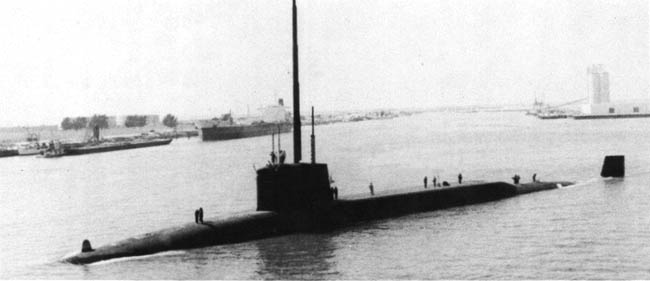
Engineers took the easiest path to gain time, choosing the existing Valiant-class SSN hull and stretching it by adding a 16 tubes section for Polaris missile launchers. Two pairs were ordered in May 1963 from Vickers, Barrow in Furness and Cammell Laird in Birkenhead. The fifth was planned as HMS Ramillies but cancelled in February 1965 under Harold Wilson’s administration. The missile compartment was located between the fin and nuclear reactor as per US practice on the USS Washington design (launched 1961). With 130 metres (430 ft) long for 10.1 metres (33 ft) and 9 metres (30 ft), displacing 8,400 long tons (8,500 t) submerged, they were the largest British submarines ever built;
They were given a Rolls-Royce pressurised water reactor PWR1 and two English Electric Company turbines for 25 knots (46 km/h) submerged, with a diving depth of 275 metres (902 ft). They still had six 533-millimetre (21 in) bow torpedo tubes with the Tigerfish wire-guided homing torpedo. According to Naval Constructors R.J. Daniel, these boats had features that would be copied by the USN, such as the machinery loading hatch, automated hovering system, welded hull valves, standardised valves, plus the usual raft-mounted propulsion machinery making them extremely silent.
Just like for France, it was chosen to built four SSBNs in order to have two at sea at all times, allowing another to be one in maintenance and another ready for replacement on the patrol course. Commissioned in 1967-69, all four were decommissioned in 1992-95. Cost per unit on average was £39 million.
Development
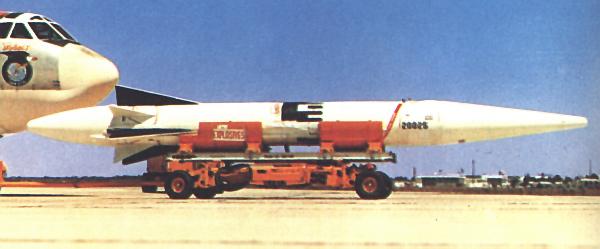
AGM-48 (Later GAM-87 Skybolt)
Acquisition of nuclear power by Britain went back to 1945 and was first adopted as a deterrence in 1952 with Operation Hurricane, detonated at Montebello on the Australian West Coast. Next the program worked out to deliver it was the RAF’s V-bombers very much like the SAC back in the US. In the early 1960s however air defence made bomber penetration for free fall vectors near-impossible without a huge attrition rate. It was already determined in 1963 that the Soviet airspace was near impenetrable, as shown by Gary Powers’s U2 shot down in May 1960 while at 70,000 feet (21 km). The very same month, British PM Harold Macmillan arranged a deal with US President Eisenhower to swap free fall bombs for AGM-48 Skybolt 1,000-mile (1,600 km) range ballistic missiles, allowing the launching bombers to remain out of Soviet airspace. The British side concentrated on adapting the missile, developing suitable mounting points on the Avro Vulcan and fit the relevant guidance systems. Later this led to develop the RE.179 to replace the W47.
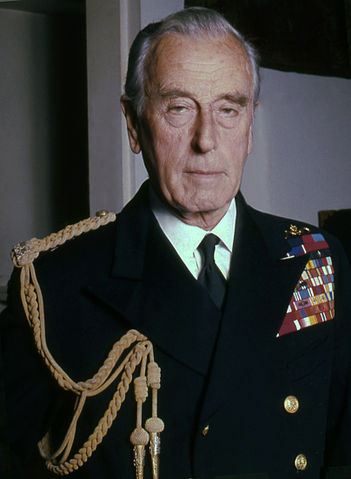 However the new Kennedy administration considered Skybolt and the dominance of the Air force on deterrent in general with suspicion and Robert McNamara was the first to criticize the dominance of the bomber fleet and its difficult head, Curtis LeMay. Like Kennedy he saw this arm as obsolete seeing the work done with ICBMs, that could be soon launched from US soil directly. Skybolt was soon seen dismissed as a “last stand” of the Air Force to keep its foothold in US deterrence and this opened the way back to the Navy (after all Kennedy was a former Navy captain). Work on ICBM and its inertial guidance systems, precision strike capability made obsolete not only free-fall bombs but even bomber-launched missiles. McNamara however was also fearful of an involvement of UK’s own nuclear force, and soon proposed a dual-key arrangement, providing ICBMs in exchange.
However the new Kennedy administration considered Skybolt and the dominance of the Air force on deterrent in general with suspicion and Robert McNamara was the first to criticize the dominance of the bomber fleet and its difficult head, Curtis LeMay. Like Kennedy he saw this arm as obsolete seeing the work done with ICBMs, that could be soon launched from US soil directly. Skybolt was soon seen dismissed as a “last stand” of the Air Force to keep its foothold in US deterrence and this opened the way back to the Navy (after all Kennedy was a former Navy captain). Work on ICBM and its inertial guidance systems, precision strike capability made obsolete not only free-fall bombs but even bomber-launched missiles. McNamara however was also fearful of an involvement of UK’s own nuclear force, and soon proposed a dual-key arrangement, providing ICBMs in exchange.
Photo: Admiral of the Fleet Lord Mountbatten, First Sea Lord from 1955 to 1959, and the Chief of the Defence Staff from 1959 to 1965 which worked with the US on the Skybolt and later Polaris Program
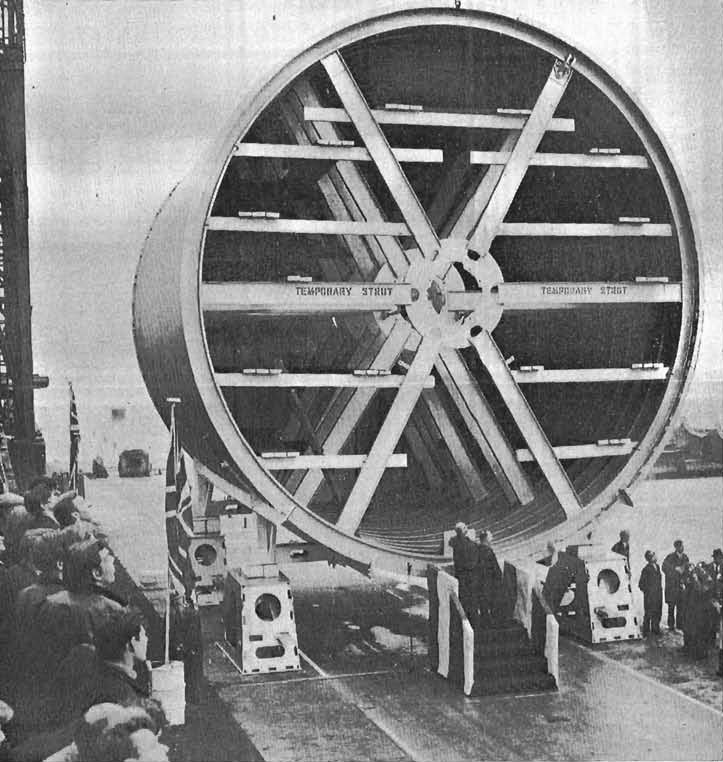
First section of HMS Resolution being laid down at Vickers in 1963.
McNamara announced to MacMillan his will to cancel Skybolt in November 1962, which rise protests at the House of Commons, until a meeting was arranged whith Macmillan reassuring the public UK would retain its independent deterrent capability. The core of the deal was the new Polaris-derived warheads leaving the Government to finance a British launch platform if required.
Kennedy eventually approved the dual-key arrangement and the UK gained the Polaris system, starting development of a platform. The US already had a head start with the Washington class, shortcutting by the adoption of the Skipjacks as a base. It was soon made clear that these would take on the nuclear deterrent role from 1968. This was concomitant also with difficult years for the RAF, seeing the cancellation of many programs.
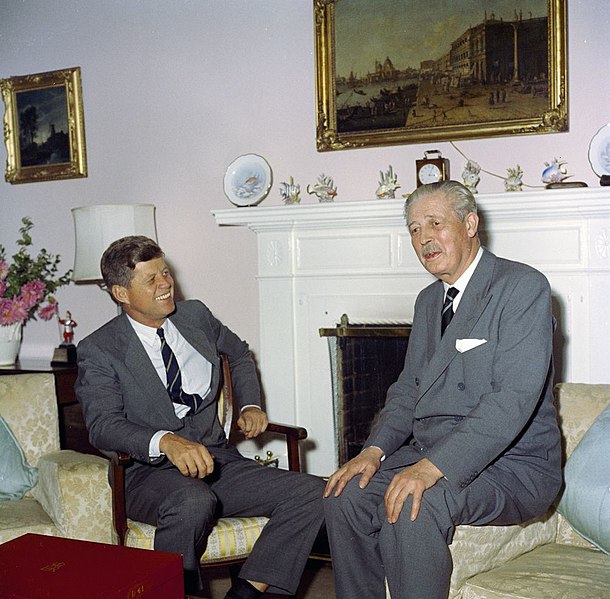
The Nassau Agreements between Kennedy and MacMillan solidified the British SLBM deterrence up to this day.
Design of the class

Cutaway of the HMS Resolution (S22). Nuclear deterrence soon imposed domestic SSBNs, active by 1967.
In 1962 however, Britain just started with nuclear propulsion with HMS Dreadnought, launched in 1960 and just completed. The acquisition of the US S5W reactor was already hard-fought, and now with Polaris, the work still at hands remains daunting. It was at first proposed the same approach as in the USN taking the Dreadnought design and stretching it by adding a missile silos section. However it was already seen a bit small, and in late 1962 the British obtained better than the missile itself and its fire control systems, the US proposed to provide the whole complete section with its 16 silos. Now a hull was needed to built around it.

Model at RAF Cosford
The Dreadnought design was already dating back from 1959 in addition not to have the required diameter, so it was decided instead to take the next iteration of British SSN as a base, the larger Valiant class, then in the works. When agreed, it was decided that by May 1963 when orders were placed, Vickers Armstrong in Barrow-in-Furness would built HMS Resolution and Repulse and Cammell Laird in Birkenhead HMS Renown and Revenge, and only the bow and stern before being assembled with the American-designed missile compartment when it was provided. Both the bow and stern were a modification of the Valiant class. As said above, the option for a fifth unit, HMS Ramillies, was cancelled in February 1965 by PM Harold Wilson. Following the new tradition setup by Dreadnought, capital ships names were used.
Hull and general design

Profile by Mike1979Russia, CC
The design retook essentially the bow and stern of the Valiant-class to late included between them the missile compartment, between the sail and nuclear reactor. Thus, the full lenght ended at 130 metres (430 ft) for a beam of 10.1 metres (33 ft) and an height of 9 metres (30 ft), for an overall displacement of 7,600 long tons (7,700 t) surfaced, 8,400 long tons (8,500 t) submerged. By making the hull deeper compared to US SSBNs, the new design had a more streamlined back and smaller “hump”, and no “shoulders” around the fin. This was a much more larger and beefier design than the G. Washington or Ethan Allen of the USN and instead closer to the later Lafayette class.
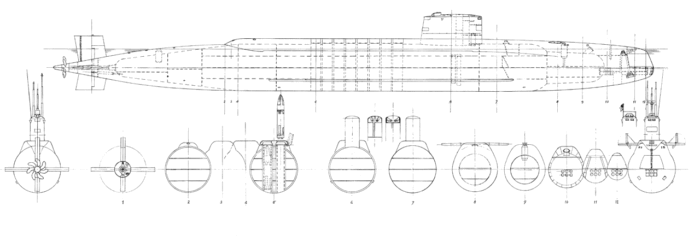

HMS Resolution, blueprints, on the blueprints page (orig. unknown)
The next design feature was the new British developed Rolls-Royce pressurised water reactor (PWR1) to replace the US S5W, coupled with and English Electric turbines for 25 knots (46 km/h) top speed. This design was able to dive below 275 metres (902 ft), better than the 700 ft of US SSBNs. By that stage the missile adopted were Polaris A3 in two rows of eight, so sixteen in all. As a backup there was a diesel generator, notably to power the pumps for the ballasts after for example a “scramble”. Like the Valiant there were the same sonar and six 21 inches torpedo tubes capable of operating the new Tigerfish wire-guided homing torpedo. The crew was the largest on record for a British submarine, at 143. Plus tyey had a machinery loading hatch, and automated hovering system as well welded hull valves which were also standardised valves plus a new generation raft-mounted propulsion machinery which was reputed better than the US system.
They also had the same peculiarly shaped bow and nose dive planes plus the same narrow sail as the Valiant class.
Powerplant

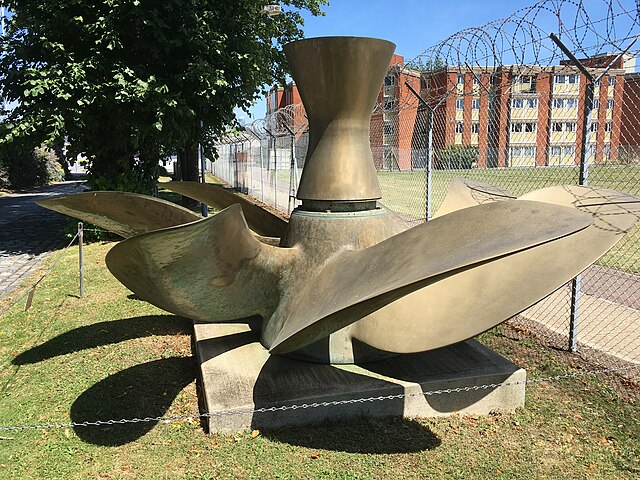
The 7-bladed hooked propeller of the class
Like the Valiant, the Resolution class share its single propeller, shaft, tail, and propulsion by a Vickers/Rolls-Royce PWR1 pressurised-water nuclear reactor via a pair of electric turbines for a total output of 27,500 shp (20.5 MW). To compare, the 4,400/4,900 long tons Valiants reached 15,000 hp and were two knots faster underwater. The Resolution class reached 20 kn (37 km/h) while surfaced and 25 knots (46 km/h) submerged and range was unlimited except by food supplies. She also had a 4,000 brake horsepower (3,000 kW) diesel engine providing auxiliary power. Thius was a safety featyre to ensure she still could used her ballasts and surface if needed and power her diving planes or drive essentials systems until her main reactor was operational again.
It should be noted that Britain did not introduced the equivalent as the SUBSAFE sytems but interwar losses led to a greater culture of safety in construction and operations anyway.
Armament
The British Polaris Programme
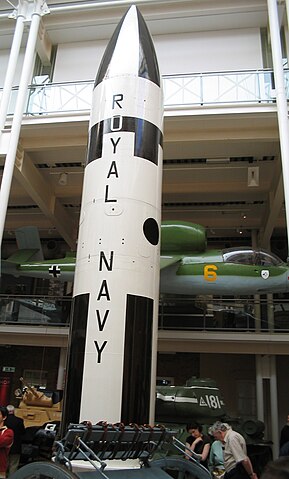 Just as the Polaris program started, US senators and naval officers suggested an association with the UK and by 1957 CNO Arleigh Burke and 1st Sea Lord Louis Mountbatten corresponded on this project. As the Blue Streak and Skybolt programs were cancelled and with the 1962 Nassau Agreement when Macmillan and Kennedy met, the deal was done to provide the Polaris missiles completed with its tubes and sub-systems as well as the fire-control systems. The warheads were to be provided by Britain.
Just as the Polaris program started, US senators and naval officers suggested an association with the UK and by 1957 CNO Arleigh Burke and 1st Sea Lord Louis Mountbatten corresponded on this project. As the Blue Streak and Skybolt programs were cancelled and with the 1962 Nassau Agreement when Macmillan and Kennedy met, the deal was done to provide the Polaris missiles completed with its tubes and sub-systems as well as the fire-control systems. The warheads were to be provided by Britain.
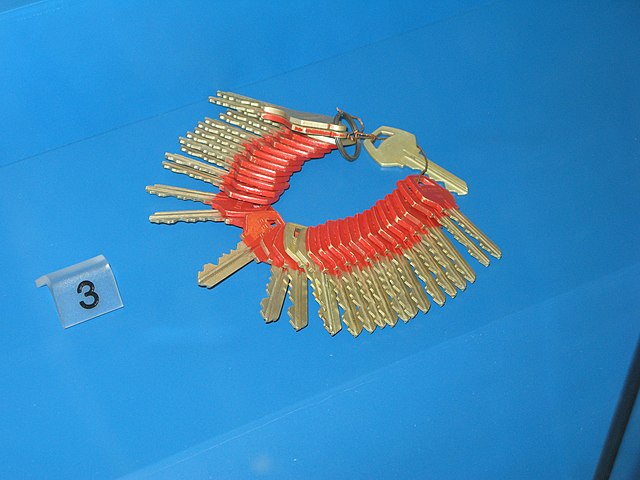
The Polaris keys onboard HMS Resolution, one per tube.
The Nassau Agreement however made the sale of the Polaris malleable in interpretation and it fell under the scope of NATO’s deterrence powers. The British could turn it conversely as a national deterrent, or at least argued it was such to the Commons The Sales Agreement was signed on April 6, 1963 but the clause not publicly trumpeted was its control in targeting to SACEUR (Supreme Allied Commander, Europe). If unsupported by NATO allies, targeting and permission to fire would still however reside with the British national authorities with express consent by the British PM.
Operational control was submitted to the head of SACLANT, a US admiral based near Norfolk, Virginia, then delegated to its deputy commander in the Eastern Atlantic area (COMEASTLANT) a British admiral.
Polaris was still a massive program for postwar Britain, and in 1964 the new Labour government considered even cancelling it and even suggested to turn the new SSBNs back into SSNs. However studied changed their minds given the souvenir of Suez and provided still a global nuclear capacity east of Suez to a cost £150 million less for the V bomber force. This proghram, for once, was completed on time and within budget.
On 15 February 1968, HMS Resolution was the first British vessel to fire a Polaris. Soon all four were based in Faslane base, a few miles from Holy Loch, in a brtand new facility that allowed the twin crews to rotate. The two pairs ensured there was always one in refit, one in between deployment, and two in deterrent patrol. Recenlty declassifed archives disclose that there were “only” four boatloads of reentry vehicles and warheads plus spare. Newt when deployed with the Chevaline warhead, this was reduced to three boatloads or 43 SLBMs total.
⚙ specifications Polaris A3 (UGM-27C) |
|
| Weight | 36,000 Ibs (16,329 kg) |
| Dimensions | 32 ft (9.7 m) x 4 ft. 6 in (1.37 m) |
| Propulsion | 2-stage solid propellant |
| Speed | Supersonic, classified |
| Range | 500 (926 km)- 2,500 n.miles (4,630 km) |
| Guidance | Inertial |
| Ceiling | Stratospheric |
| Accuracy | 3,000 ft (900 m) C.E.P. |
| Payload | 3x MIRV ET.317 thermonuclear, 200 kt. |
The Chevaline Program

The original Polaris was not designed to penetrate Soviet anti-ballistic missile defenses, but the Royal Navy wanted to ensure could do this with just only one submarine on deterrent patrol and so was developed a British variant, the Polaris A3T from 1968 to 1972. Britain soon worked out a new generation of missiles thorough the US “Antelope program” to alter the Polaris, managed through a serie of tests at a British facility in Aldermaston. Evaluation by the British led to follow the modifications done in the United States under the name of Chevaline.
This consisted in adding decoys and chaff launchers as well as EW countermeasures. The program was declassified in 1980 due to cost overruns (which quadrupled), when approved in January 1975. It soon ran into trouble with the Labour Party and their Chief Scientific Adviser, Solly Zuckerman. Buy the program still found supporters such as the Secretary of State for Defence, Denis Healey.
The cost of the project led to cancellation in 1977 albeit it became still operational in mid-1982 on HMS Renown and ported on all British SSBNs until withdrawn from service in 1996.
Torpedo Armament
Thus was the same armament and likely the same stock of 32 vectors as the Valiant class.
Mark 20C Torpedo:
An improvement of the Mark 20S Torpedo, first British passive homing torpedo entering service in 1955. The Mark 20C was developed in the early 1960s, susperseded by the Tigerfish in the 1980s.
They were “short” torpedoes and used notably in the Oberon’s rear tubes.
⚙ specifications Mark 20C
Weight 1,810 lbs. (821 kg)
Dimensions: 254.5 in (6.464 m)
Propulsion: Battery
Range/speed setting: 7,000 yards (6,600 m)/23 knots
Warhead: 196 lbs. (89 kg)
Guidance: Homing, active/passive
Mark 23 Grog:
A wire-guided version of the Mark 20 with dual-speed mode, tested from 1955 and worked on further aftere “Mackle” project was cancelled in 1956. The first were delivered in 1959 but it entered service in 1966, and considered already obsolescent, not operational until 1971. But they were never popular as thir control system was failing at extreme range.
⚙ Specifications Mark 22 Grog
Weight: 2,000 lb (907 kg)
Dimensions: 14.9 ft (4.54 m) x 21 in (530 mm)
Propulsion: Battery (perchloric acid)
Range/speed setting: 12,000 yd (11,000m)@20 knots, 8,900 yd (8,100 m)@ 28 knots
Warhead: 89 kg (196 lb) Torpex
Guidance: Wire-guided to point, passive sonar acquisition for terminal guidance
Sensors
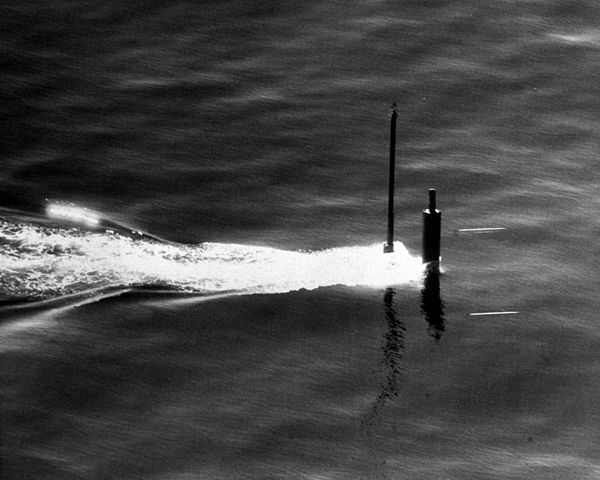
Type 1003 radar:Operating in X-band, surface+air warning and ranging. Type AKU(3) or AKS(2) antenae, derived from the 1002 radar.
Type 2001 sonar: Hull-mounted, low-frequency, detection sonar designed for nuclear-propelled submarines. Active and passive with an array of 24 flat panels carrying 56 transducers. producing 24 active search beams with a beam tilts down 20 degrees. Sonar type developed specifically for HMS Dreanought.
Type 2007 sonar: Hull mounted long-range passive sonar, upgraded from the Oberon class.
Type 2023 sonar: No data
UAB/UAC ECM suite: No data
DCB CCS: No data.

CC profile By Mike1979russia, rendered in 3D.
⚙ HMS Resolution specs. |
|
| Displacement | 7,500 long tons surfaced, 8,400 long tons submerged |
| Dimensions | 425 x 33 ft x 30 ft 1 in (130 x 10 x 9.17 m) |
| Propulsion | 1 shaft Vickers/Rolls-Royce PWR1 reactor, 2 turbines, 1 diiesel 27,500 shp (20.5 MW) |
| Speed | 20 knots (37 km/h) surfaced, 25 knots (46 km/h) |
| Range | Unlimited but for food supplies |
| Armament | 16x Polaris A3 SLBM, 6× 21 in (533 mm) bow TTs (32? Mark VIII/Tigerfish) |
| Sensors | Type 1003 radar, type 2001, type 2007, type 2023 sonars, UAB/UAC ECM suite, DCB CCS |
| Crew | 143, two crews as in US practice |
Upgrades
Renown was upgraded in 1982, Resolution in 1984, Repulse in 1986 and Revenge in 1988 with the following:
Sensors:
-Type 1006(1) radar replacing the Type 1003
-Type 2019 PARIS Underwater acoustic recognition system, replacing the 2023.
-Type 2047 sonar, combined with the 2019.
-UAL(1) ECM suite replacing the UAB/UAC
-DCB/DCG CCS repalcing the DCB CCS.
Armament: Polaris A-3TK SLBM Chevaline warhead. The MIRVs had EW and decoys to penetrate the Soviet airspace.
Career of the Resolution class
 HMS Resolution (1966, S22)
HMS Resolution (1966, S22)
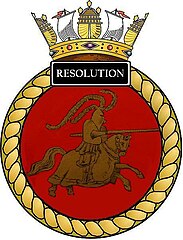 HMS Resolution was ordered in May 1963 and built at Vickers Shipbuilding Ltd, Barrow-in-Furness, laid down on 26 February 1964, launched on 15 September 1966 and commissioned on 2 October 1967. After her sea trials she was assigned to the 10th Submarine Squadron, as the first Polaris British deterrent force. With 16 missiles, she could deliver 18 thermonuclear 200 kt warhead around Moskow. Her patrol logs are not published yet. In her early carrer with the upsurge of Soviet SSN activity, she managed to evade November-class submarines and stay hidden during her 72-90 days patrols.
HMS Resolution was ordered in May 1963 and built at Vickers Shipbuilding Ltd, Barrow-in-Furness, laid down on 26 February 1964, launched on 15 September 1966 and commissioned on 2 October 1967. After her sea trials she was assigned to the 10th Submarine Squadron, as the first Polaris British deterrent force. With 16 missiles, she could deliver 18 thermonuclear 200 kt warhead around Moskow. Her patrol logs are not published yet. In her early carrer with the upsurge of Soviet SSN activity, she managed to evade November-class submarines and stay hidden during her 72-90 days patrols.

In the 1982 early days of the Falklands War, BBC World News reported incorrectly she was stationed off Buenos Aires and a similar announcement was made in 1984 this time off Córdoba in case a Royal Navy aircraft carrier was threatened.
In 1984-86 she underweent her major upgrade, with the new Chevaline IFE including two new warheads and re-entry bodies and penaids wich were super-hardened to resist ABM attack, instead of the three original ET.317 warheads. The while radar and sonar suite was upgraded as well as the fire control system. HMS Resolution performed the longest patrol of any Polaris submarine by stating at sea for 108 days in 1991.
With the completion of the first Trident armed Vanguard-class in 1992, HMS Resolution was removed from service and decommissioned on 22 October 1994, after 69 patrols. She was laid up at the Rosyth Dockyard, main basin at Rosyth and had her reactor defuelled. The MOD planned her final removal of the radioactive reactor parts and scrapping for over a decade. The debate was relaunched in 2011 while other boats joined her at Rosyth.
 HMS Repulse (1967, S23)
HMS Repulse (1967, S23)
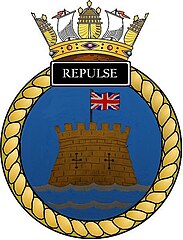 HMS Repulse was laid down on 12 March 1965 at Vickers like her sister Resolution, launched on 4 November 1967 and commissioned on 28 September 1968. She was baptised by Lady Joan Zuckerman, wife of the Chief Scientific Advisor. She ran aground in the Walney Channel during launch but was undamaged and fully able to be towed for completion at high tide. She was originally the third in class, but delays with HMS Renown at Cammell Laird had her commissioned second. She was also the latest decommissioning, in 1996.
HMS Repulse was laid down on 12 March 1965 at Vickers like her sister Resolution, launched on 4 November 1967 and commissioned on 28 September 1968. She was baptised by Lady Joan Zuckerman, wife of the Chief Scientific Advisor. She ran aground in the Walney Channel during launch but was undamaged and fully able to be towed for completion at high tide. She was originally the third in class, but delays with HMS Renown at Cammell Laird had her commissioned second. She was also the latest decommissioning, in 1996.
No detailed logs (so far).
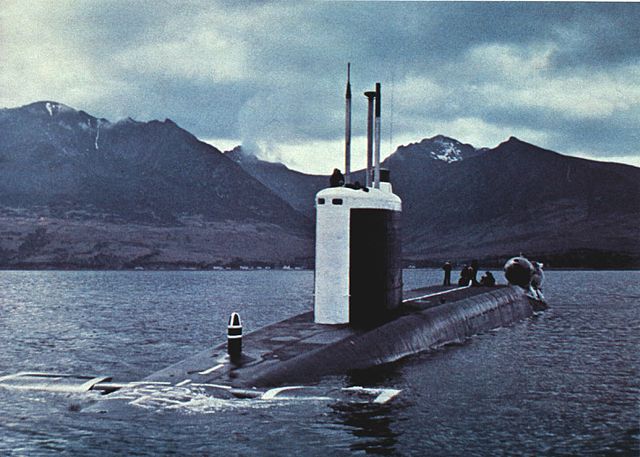
HMS Repulse in the firth of Clyde, winter 1979, note the experimental paint of her sail.
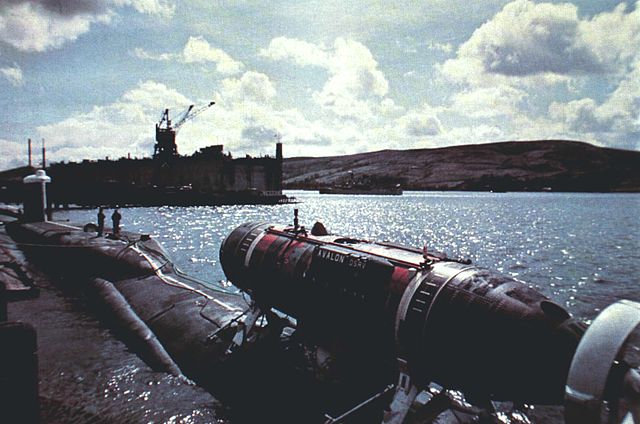
DSRV-2 Avalon on Repulse in 1979
She hosted a BBC film crew for her deployment in 1984 showing how went a 8 week long deployment and also filiming the family members on land. This was broadcast in February 1985, in 6 film series on the Royal Navy Submarine Service. As of 2024 she still stored at Rosyth and waiting disposal.
 HMS Renown (1967, S 26)
HMS Renown (1967, S 26)
 HMS Renown was ordered on 8 May 1963, laid down at Cammell Laird’s Birkenhead shipyard on 25 June 1964 but construction was delayed, with poor performance from the workforce so both her and Revenge being delayed. In 1966 it was realized rthat the Yard had a lax interpretation of drawings so much so her torpedo storage compartment was shorter by one inch (2.5 cm). Also during an intermediate yard inspection, broken bits of metal were found in her primary cooling circuits so they needed to be removed, inspected and refitted again. This alone cost two months. She was eventually launched on 25 February 1967 by Edna Healey, wife of Denis Healey, Secretary of State for Defence. The situation for her completion was so bad that by October 1967, when the yard announced she was six months behind schedule, the Ministry of Defence considered towing her to Vickers-Armstrongs, but the did not happened and she was formally commissioned on 15 November 1968.
HMS Renown was ordered on 8 May 1963, laid down at Cammell Laird’s Birkenhead shipyard on 25 June 1964 but construction was delayed, with poor performance from the workforce so both her and Revenge being delayed. In 1966 it was realized rthat the Yard had a lax interpretation of drawings so much so her torpedo storage compartment was shorter by one inch (2.5 cm). Also during an intermediate yard inspection, broken bits of metal were found in her primary cooling circuits so they needed to be removed, inspected and refitted again. This alone cost two months. She was eventually launched on 25 February 1967 by Edna Healey, wife of Denis Healey, Secretary of State for Defence. The situation for her completion was so bad that by October 1967, when the yard announced she was six months behind schedule, the Ministry of Defence considered towing her to Vickers-Armstrongs, but the did not happened and she was formally commissioned on 15 November 1968.
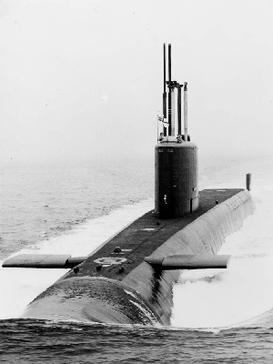 Renown struck a dock entrance when leaving Lairds for her sea trials in February 1969. Damage was light. On 13 October she collided with the merchant ship MV Moyle in the Irish Sea and her commanding officer was found guilty and after a court-martial, relieved of command. She was declared fully operational by November 1969 and joined her sisters to start patrols.
Renown struck a dock entrance when leaving Lairds for her sea trials in February 1969. Damage was light. On 13 October she collided with the merchant ship MV Moyle in the Irish Sea and her commanding officer was found guilty and after a court-martial, relieved of command. She was declared fully operational by November 1969 and joined her sisters to start patrols.
In 1974 she struck the sea bottom when diving trials off Scotland and was drydocked for repairs.
She had her 1980s refit Renown after which she test firied the Chevaline in early 1982, operational later that year. However due to her initial construction she would suffer from defects all along her career, and as they accumulated it was decided to keep her at Faslane in 1995, and she was decommissioned on 24 February 1996, since awaiting disposal.
 HMS Revenge (1968, S 27)
HMS Revenge (1968, S 27)
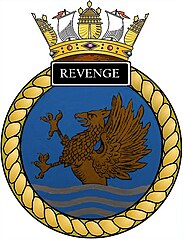 Ordered like the others on 8 May 1963, Revenge became the fourth in class, laid down at Cammell Laird on 19 May 1965 but construction dragged on so much that after her launch on 15 March 1968 the Ministry of Defence considered towing her for completion at Vickers-Armstrongs. She was formally commissioned on 4 December 1969, many moths beyond schedule and had a serie of mishaps. In fact the workforce even nicknamed the “gravy boats” as they were seen as “easy money”.
Ordered like the others on 8 May 1963, Revenge became the fourth in class, laid down at Cammell Laird on 19 May 1965 but construction dragged on so much that after her launch on 15 March 1968 the Ministry of Defence considered towing her for completion at Vickers-Armstrongs. She was formally commissioned on 4 December 1969, many moths beyond schedule and had a serie of mishaps. In fact the workforce even nicknamed the “gravy boats” as they were seen as “easy money”.
Following commissioning, she had extensive sea trials and work-up and sailed for the US test Polaris range at Cape Canaveral of Florida by June 1970.
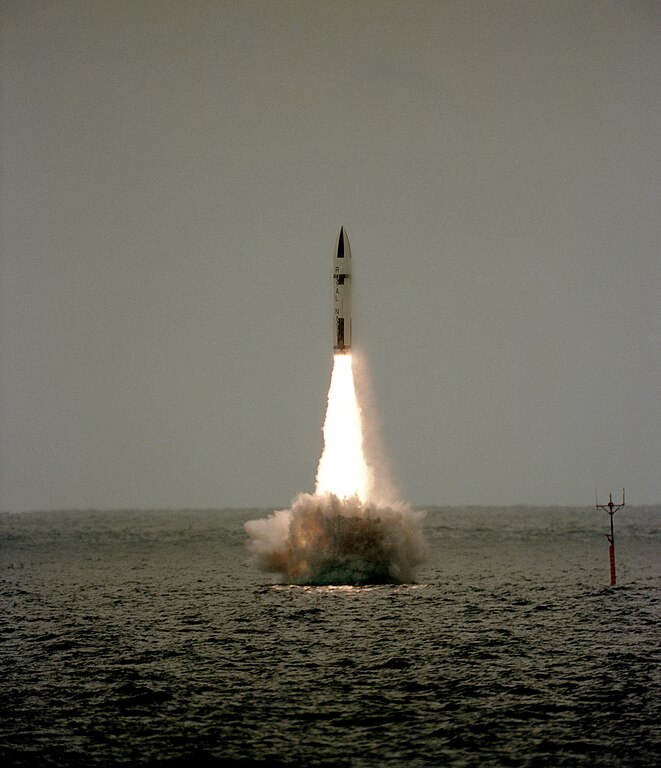
Missile test by HMS Revenge off Cape Canaveral Air Force Station, 10th Polaris test flights, 9 June 1983
Detail of her patrols are still classified. She was part of the 10th subRon at HM Naval Base Clyde (HMS Neptune), 40 km (25 mi) west of Glasgow, Scotland, and performed around 60 patrols in her 30 years career, two yearly for each alternative crew, followed by months of refit and maintenance, plus the usual core refuelling (two each) and immobilization for two years for their 1980s major refit and modernization.
She was marked for disposal in 1992 and is currently stored, pending identification of a disposal solution at Rosyth Dockyard, northern shore of the Firth of Forth, docked down for maintenance and re-preservation with a complete checkup every 12 years.
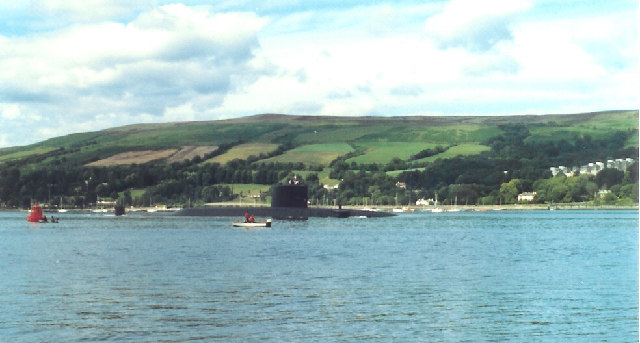
HMS Revenge in the Rhu narows, Scotland (geograph.org.uk).
All four were disposed of via MOD’s Submarine Dismantling Project (SDP) starting originally on 2016 with Swiftsure proving the technique. The method allowed to remove all Low-level radioactive waste from the vessel and radioactive intermediate-level waste. The rest was recycled for re-use by conventional ship-breaking techniques.
As for their refit, new methods of project management were used, with the appointment of a senior officer (2 star rank) as Assistant Controller (Polaris) trzming with the joint superintendence of the Controller of the Navy and Chief of Fleet Support. A designated officer named “Director, Project Technical Submarines” was the delegate, drawing up the “work package” for each refit and providing full design information and documentation, then a fully integrated refit management team at Rosyth and full use of available management techniques and computers in the process.
Read More/Src
Books
Royal Aeronautical Society Symposium. The History of the UK Strategic Deterrent: The Chevaline Programme. 28 October 2004.
“A3T ReB Proportions”. Archived from the original on 19 September 2018. Retrieved 7 January 2013.
Public Record Office, London. DEFE 19/208 e47/2
The World’s Most Powerful Submarines, David Ross
Polaris: The History of the UK’s Submarine Force by Keith Hall, History Press, 11 june 2018
Blackman, Raymond V.B. Jane’s Fighting Ships 1971–72. London: Sampson Low, Marston & Co., Ltd.
Gardiner, Robert; Chumbley, Stephen, eds. (1995). Conway’s All the World’s Fighting Ships 1947–1995.
Hennessey, Peter; Jinks, James (2016). The Silent Deep: The Royal Navy Submarine Service since 1945. Penguin Books
Links
rnsubs.co.uk/ polaris.html
web.archive.org/ mcis.soton.ac.uk/
web.archive.org skomer.u-net.com
seaforces.org/ Resolution-class.htm
nationalinterest.org/ resolution-class-ssbn
en.wikipedia.org/ ET.317
blog.nationalarchives.gov.uk hms-resolution 1st
hms-repulse.co.uk/history.html
genome.ch.bbc.co.uk Inside the Royal Navy’s most secret service
navypedia.org resolution.htm
nuclearinfo.org/ imp. Kiloton Bomb December 2007
nuclearcompanion.com/ polaris-a-3
Submarines ww2 to present, David Ross, Chris Bishop
en.wikipedia.org Polaris UK nuclear programme
Videos
Pathé Archives, lead boat sea trials in 1968

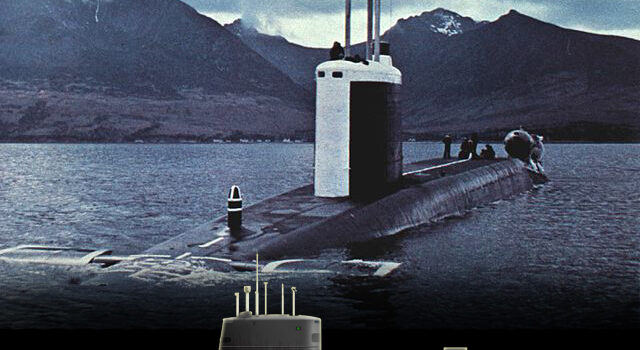
 Latest Facebook Entry -
Latest Facebook Entry -  X(Tweeter) Naval Encyclopedia's deck archive
X(Tweeter) Naval Encyclopedia's deck archive Instagram (@navalencyc)
Instagram (@navalencyc)





 French Navy
French Navy Royal Navy
Royal Navy Russian Navy
Russian Navy Armada Espanola
Armada Espanola Austrian Navy
Austrian Navy K.u.K. Kriegsmarine
K.u.K. Kriegsmarine Dansk Marine
Dansk Marine Nautiko Hellenon
Nautiko Hellenon Koninklije Marine 1870
Koninklije Marine 1870 Marinha do Brasil
Marinha do Brasil Osmanlı Donanması
Osmanlı Donanması Marina Do Peru
Marina Do Peru Marinha do Portugal
Marinha do Portugal Regia Marina 1870
Regia Marina 1870 Nihhon Kaigun 1870
Nihhon Kaigun 1870 Preußische Marine 1870
Preußische Marine 1870 Russkiy Flot 1870
Russkiy Flot 1870 Svenska marinen
Svenska marinen Søværnet
Søværnet Union Navy
Union Navy Confederate Navy
Confederate Navy Armada de Argentina
Armada de Argentina Imperial Chinese Navy
Imperial Chinese Navy Marinha do Portugal
Marinha do Portugal Mexico
Mexico Kaiserliche Marine
Kaiserliche Marine 1898 US Navy
1898 US Navy Sovietskiy Flot
Sovietskiy Flot Royal Canadian Navy
Royal Canadian Navy Royal Australian Navy
Royal Australian Navy RNZN Fleet
RNZN Fleet Chinese Navy 1937
Chinese Navy 1937 Kriegsmarine
Kriegsmarine Chilean Navy
Chilean Navy Danish Navy
Danish Navy Finnish Navy
Finnish Navy Hellenic Navy
Hellenic Navy Polish Navy
Polish Navy Romanian Navy
Romanian Navy Turkish Navy
Turkish Navy Royal Yugoslav Navy
Royal Yugoslav Navy Royal Thai Navy
Royal Thai Navy Minor Navies
Minor Navies Albania
Albania Austria
Austria Belgium
Belgium Columbia
Columbia Costa Rica
Costa Rica Cuba
Cuba Czechoslovakia
Czechoslovakia Dominican Republic
Dominican Republic Haiti
Haiti Hungary
Hungary Honduras
Honduras Estonia
Estonia Iceland
Iceland Eire
Eire Equador
Equador Iran
Iran Iraq
Iraq Latvia
Latvia Liberia
Liberia Lithuania
Lithuania Mandchukuo
Mandchukuo Morocco
Morocco Nicaragua
Nicaragua Persia
Persia San Salvador
San Salvador Sarawak
Sarawak Uruguay
Uruguay Venezuela
Venezuela Zanzibar
Zanzibar Warsaw Pact Navies
Warsaw Pact Navies Bulgaria
Bulgaria Hungary
Hungary

 Bundesmarine
Bundesmarine Dutch Navy
Dutch Navy Hellenic Navy
Hellenic Navy Marina Militare
Marina Militare Yugoslav Navy
Yugoslav Navy Chinese Navy
Chinese Navy Indian Navy
Indian Navy Indonesian Navy
Indonesian Navy JMSDF
JMSDF North Korean Navy
North Korean Navy Pakistani Navy
Pakistani Navy Philippines Navy
Philippines Navy ROKN
ROKN Rep. of Singapore Navy
Rep. of Singapore Navy Taiwanese Navy
Taiwanese Navy IDF Navy
IDF Navy Saudi Navy
Saudi Navy Royal New Zealand Navy
Royal New Zealand Navy Egyptian Navy
Egyptian Navy South African Navy
South African Navy






























 Ukrainian Navy
Ukrainian Navy dbodesign
dbodesign